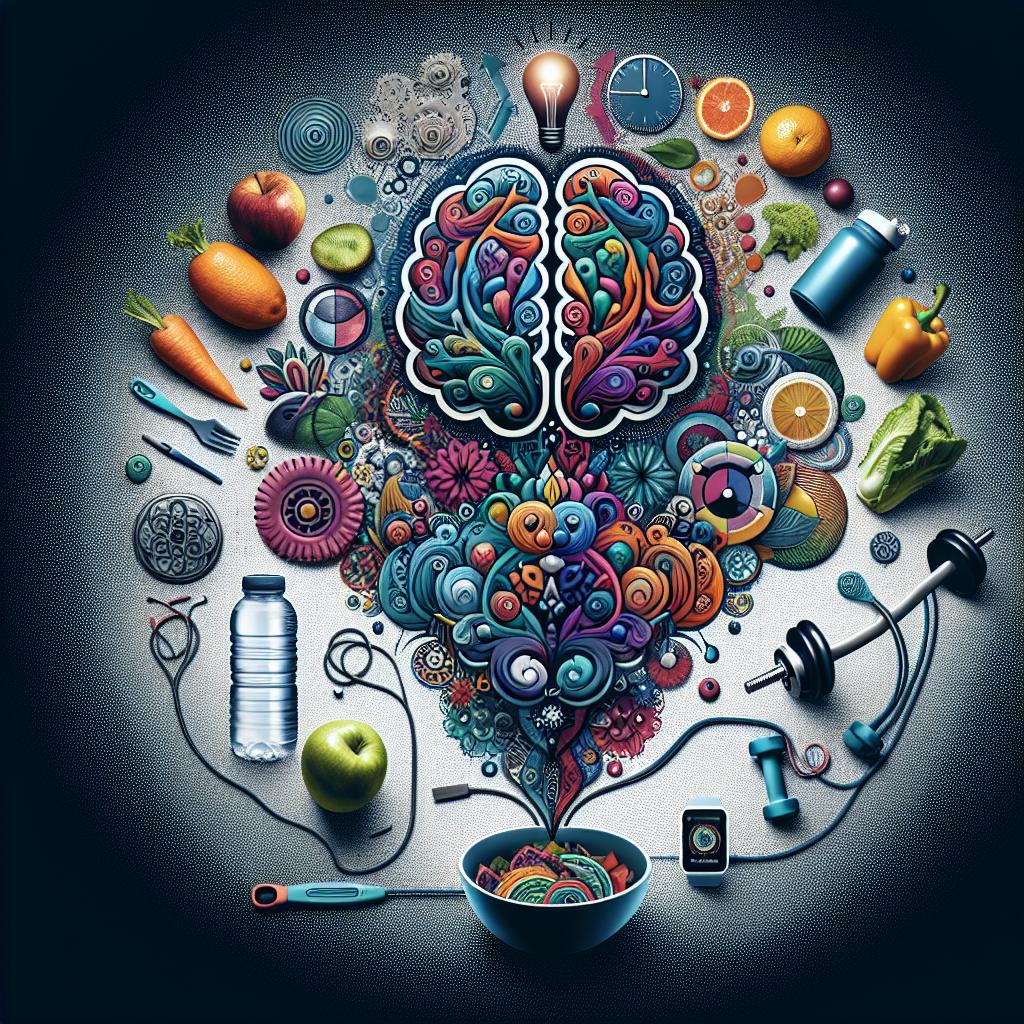
“7 Tips for Incorporating Mindfulness Into Your Eating Habits”
Imagine savoring each bite of your meal as if it were the first and last morsel you’ll ever taste—feeling the textures, relishing the flavors, and truly experiencing the act of eating. In our fast-paced world where drive-thru meals and desktop dining have become the norm, the ancient practice of mindfulness might just be the secret ingredient missing from our daily menu. Mindfulness, a state of active, open attention to the present, can transform a routine lunch into a revitalizing ritual. This article isn’t about fad diets or quick fixes; it’s an invitation to a culinary journey that will reconnect you with the joy of eating. Here are seven delectable tips for weaving mindfulness into your eating habits, turning each meal into a feast for the senses and nourishment for the soul. Get ready to indulge in the art of mindful eating, where every bite is a meditation and every meal, a mindful masterpiece. Join us as we embark on a taste adventure that promises not only to enhance your palate but also to elevate your overall well-being. Bon appétit to a more conscious, connected, and contented you.
Table of Contents
- Embrace the Art of Slow Dining
- Savor Each Bite with Senses Wide Open
- Creating a Mindful Kitchen Space
- Banish Distractions for a Zen Dining Experience
- Tune Into Your Body’s Hunger Signals
- The Magic of Mindful Chewing
- Cultivate Gratitude for Earth’s Bounty at Every Meal
- Q&A
- Insights and Conclusions
Embrace the Art of Slow Dining

In a world where fast food and faster lifestyles rule, taking the time to savor your meals can seem like a luxury you can’t afford. But what if resetting the pace of your dining could offer you not just a moment of peace, but a host of mindfulness benefits? Transform your meals into a deliberate practice that nourishes not only your body but your soul.
Ditch the Digital Distractions. Begin by shutting off the TV, silencing your phone, and saying goodbye to scrolling through social media. An undistracted meal paves the way for you to fully engage with the flavors, textures, and aromas of your food. Make a clear, intentional space at your dining table that invites focus, creating an environment that supports your journey to conscious consumption.
- Arrange your dining area to be inviting and comfortable.
- Choose tableware that you love – it’s not just about the food, but also the experience.
- Let the act of eating be your single-task during mealtime.
Chew with Intent. It’s not simply about eating slower; it’s about eating smarter. As you taste each bite, chew thoughtfully and pay attention to how your food breaks down, releasing different flavors and textures. This isn’t just beneficial for digestion; it’s an exercise in being present. Aim for 20-30 chews per bite to start the process of mindful mastication.
| Food Texture | Flavor Release |
|---|---|
| Crispy | Initial crunch followed by underlying notes |
| Creamy | Richness that envelops the palate |
| Fibrous | Gradual unfolding of earthy tastes |
Let mindfulness transform each meal into an edible anthem sung by your senses. As you dedicate yourself to the art of slow dining, you’ll discover a world within each dish. Engage with your food in a way that commands your full attention, turning each meal into a practice of present-moment awareness. Embrace this approach and watch your relationship with food—and perhaps with life itself—deepen profoundly.
Savor Each Bite with Senses Wide Open

Imagine transforming every meal into a multisensory experience, where your awareness is entirely focused on the flavors, textures, and aromas before you. Integrating mindfulness into your eating can enrich your relationship with food and promote a deeper appreciation for the nourishment it provides. This practice is about more than just eating slowly—it’s about connecting to your food with intention.
Begin by analyzing the colors on your plate—let the vibrant hues of fresh produce create a visual feast that beckons you to taste. As you take a bite, pay close attention to the texture; let the crunch, smoothness, or creaminess fully register. By doing this, you naturally slow down, and your brain has the chance to signal fullness, potentially leading to healthier portion sizes and improved digestion.
- Explore the unique flavors of each ingredient—like the zesty punch of citrus or the earthy undertones of root vegetables.
- Let the aroma draw you in, teasing your taste buds before you even take a bite.
- Listen to the sounds that accompany your meal, the sizzle, the crunch, and the clink of fork against plate.
Finally, let’s not forget the power of gratitude. Reflect on the journey your food took to reach you, the effort and resources invested. A moment of thanks can create a sense of connection to the world around you, making the eating experience about sustenance and appreciation.
| Day of the Week | Main Ingredient | Sensation Focused On | Gratitude Note |
|---|---|---|---|
| Monday | Spinach | Texture | For the soil’s nutrients |
| Wednesday | Salmon | Flavour | For the ocean’s bounty |
| Friday | Strawberries | Aroma | For the farmer’s care |
Through mindfulness, every meal becomes an opportunity for pleasure and reflection. By embracing these practices, you empower yourself to create a more meaningful and healthful eating ritual. It’s a journey that goes far beyond sustenance—it is a celebration of life and a practice in living fully.
Creating a Mindful Kitchen Space

Mindfulness isn’t limited to meditation cushions or yoga mats; it graciously extends its reach into every corner of our lives, including the kitchen. It’s said that a kitchen crafted with intention becomes a sanctuary of sensuous delights and tranquility. The act of cooking transforms into a dance between flavors and awareness, and each meal becomes an opportunity to nourish both body and soul.
- Infuse Calm with Color: Color can significantly affect your mood, so choose kitchen hues that inspire serenity and reflection. Soft blues and calming greens can create a tranquil atmosphere, while warm neutrals like oatmeal or almond can invoke a grounded, nurturing feeling.
- Clear the Clutter: A harmonious space is free of chaos. Dedicate time to declutter countertops, organize your pantry, and streamline utensils and appliances. Having a designated place for everything invites a sense of order and ease into your cooking practice.
- Sensory Delights: Appeal to your senses by incorporating elements such as fresh herbs for scent, textured linens for touch, and ambient music or the soft chime of wind chimes for auditory relaxation. Engaging your senses allows for a deeper connection with the present moment.
- Mindful Lighting: Lighting can alter the vibe of your kitchen dramatically. Try implementing layers with dimmable lights for evenings, warm under-cabinet lighting for tasks, and maybe a picturesque window to invite natural light and provide a serene outlook.
As you begin to see your kitchen as more than just a food prep area, imagine it as a stage for mindfulness. Every drawer you open, every spice you sprinkle, becomes part of a conscious ritual; you’re not just making a meal, you’re cultivating awareness and appreciation.
| Element | Contribution to Mindfulness |
|---|---|
| Colors | Set mood and tone of the space. |
| Decluttering | Creates order, reducing stress and distraction. |
| Sensory Engagement | Fosters connection with the environment and present moment. |
| Lighting | Affects energy levels and atmosphere; enables focus. |
Envision these suggestions not just as decor tips but as ingredients—each one individually chosen to create a wholesome and mindful eating experience. Just as we artfully blend herbs and spices, so too should we skillfully compose our physical spaces to feed our spirits. Your kitchen is potentially a powerful place of intention; it’s time to turn it into a refuge where mindfulness can flourish alongside aromatic stews and fresh salads.
Banish Distractions for a Zen Dining Experience

Creating a serene environment for your meals goes a long way in enhancing mindfulness. Think of your dining area as a sanctuary where calmness resides and the outside world’s chaos is left at the door. Here’s how to turn mealtime into a tranquil retreat:
Clear the Clutter: Before even taking a seat, ensure that your dining space is free of unnecessary items. A cluttered table can lead to a cluttered mind. Keep your eating surface pristine, perhaps with a simple centerpiece such as a vase of flowers or a small potted plant to bring a touch of nature and purity to your space.
In the whirlwind of daily life, electronic devices are a constant source of diversion. For a truly zen-like dining experience, enforce a no-screens policy at the table. This means saying goodbye to phones, tablets, and the television. Here’s a helpful table showcasing what to keep off the dining table:
| Keep Off the Table |
|---|
| Smartphones |
| Tablets |
| Laptops |
| Television Remotes |
Engage Your Senses: Mindful eating is a multisensory experience. Focus on the colors, textures, and aromas of your food. Consider dimming the lights and playing some soft ambient sounds or soothing instrumental music in the background. Such a sensory mix will help to ground you in the present moment, allowing you to savor each bite fully.
Mindful Decor: The aesthetics of your dining area can greatly influence your level of focus and relaxation. Opt for colors and decor that promote tranquillity, such as soft blues, greens, or neutral tones. If possible, set your dining area with a view of the outdoors or add elements that mimic nature like a small fountain or wind chimes.
By incorporating these thoughtful touches, you give yourself the gift of a peaceful dining experience that nourishes both your body and soul. Every meal becomes an opportunity to connect deeply with your food and your senses, transforming the act of eating into a meditative practice.
Tune Into Your Body’s Hunger Signals

Mindful eating is about becoming fully attuned to the experience of food, and a big part of that is listening to your natural hunger cues. Often, we eat because we’re bored, stressed, or simply because it’s a certain time of day. But tuning into your body’s hunger signals can transform your relationship with food, leading to healthier behaviors and ultimately greater well-being.
First, start by pausing before eating and asking yourself if you’re truly hungry. Keep a journal or use an app to track your hunger levels before and after meals. This isn’t about restriction; it’s about awareness. Are you reaching for a snack out of habit or true hunger? Next, experiment with rating your hunger on a scale from 1 to 10, with 1 being not hungry at all and 10 being so hungry you could eat anything in sight.
- Eat slowly and savor each bite, which can help you recognize when you’re comfortably full.
- Pay attention to physical hunger signs such as a rumbling stomach or a bit of lightheadedness, indicating it’s time to refuel.
- Distinguish between ‘mouth hunger’, which is driven by the sight, smell, or idea of food, and ‘stomach hunger’, which is the physical need for food.
Incorporating these practices into your daily routine might feel challenging at first, but just like any skill, it improves with practice. To help make things clearer, have a quick glance at the following table with examples of how to interpret your hunger signals:
| Hunger Scale | Signal | Action |
|---|---|---|
| 1-2 | Not hungry | Wait to eat |
| 3-4 | Mild signals | Consider a light snack |
| 5-6 | Noticeable hunger | Time to plan a meal |
| 7-8 | Strong hunger | Eat now to avoid overeating later |
| 9-10 | Excessive hunger | Eat mindfully to satisfy hunger without overdoing it |
By paying closer attention to these signals, not only can you make more informed decisions about when and what to eat, but you’ll also begin to appreciate food in a more meaningful way. Remember, mindful eating is not a diet—it’s about cultivating an understanding of your physical needs and honoring your body through your food choices.
The Magic of Mindful Chewing

Imagine each bite you take as an act of meditation, where the flavors, textures, and aromas align to bring you into the present moment. Mindful chewing is not just a technique; it’s a transformative experience that turns a mundane act into a symphony of senses. To truly savor your meals, it involves pausing the chatter of your mind and bringing full attention to the act of eating.
Start by slowing down and recognizing each morsel as an opportunity for mindfulness. As you chew, pay attention to the subtleties of taste unfolding, the interaction of ingredients, and how each chew changes the complexity of flavors. It’s not merely about eating slower; it’s about relishing the journey of taste and appreciating the nourishment your food provides.
- Count your chews: Aim for 20 to 30 chews per mouthful. This doesn’t only aid digestion, but it also allows ample time for mindfulness.
- Set down your utensils between bites. This small act prompts you to focus solely on the food that’s in your mouth, not on the next bite.
- Engage your senses: Notice the texture, temperature, and even the sounds of the food as you chew. This multisensory awareness can heighten the dining experience.
| Chew Count | Sensory Focus | Experience |
|---|---|---|
| 1-10 | Texture | Initial perception of food’s structure |
| 11-20 | Flavor | Unlocking layers of taste |
| 21-30 | Satisfaction | Fulfillment and satiety signals |
Embrace the silence that mindful chewing offers. Reducing distractions, whether that’s turning off the TV or stepping away from your desk, allows your meal to take center stage. In the quiet, you begin to hear the conversation between your mind, body, and plate—a dialogue that is often drowned out by life’s noise. This practice not only increases the enjoyment of your food but can also be the cornerstone of a healthier relationship with eating.
Cultivate Gratitude for Earth’s Bounty at Every Meal

Embracing the fullness of what our planet provides starts right at the dinner table. Reflecting on the herculean journey your food has taken from seed to plate awakens a sense of deep appreciation. With a few purposeful practices, you can transform your meals into a meditation of gratitude for the earth’s rich offerings.
Begin with a Moment of Silence: Before the first bite, pause. Close your eyes for a moment. Envision the farmers toiling in the field, the truck drivers hauling the harvest, the grocers stocking the shelves, and the cook’s meticulous preparation. Acknowledge their collective effort with a silent ‘thank you.’ This simple act sets the tone for a meal consumed with mindfulness and thankfulness.
- Appreciate the colors and shapes on your plate.
- Inhale deeply, savoring the aromas.
- Chew slowly, releasing the symphony of flavors.
Engage All Your Senses: Tuning into your senses elevates the experience of eating from mere sustenance to a celebration of the senses. Observe the vibrant hues of a vegetable medley or the steam rising from a hot bowl of soup. Each sensory detail heightens your consciousness of the natural abundance that sustains us.
| Sense | Action |
| Sight | Admire your meal’s colors and presentation |
| Smell | Inhale the aromas deeply before each bite |
| Taste | Identify each distinct flavor as you chew |
| Touch | Feel the texture of your food |
| Hearing | Listen to the sound of crunchy vegetables or sizzling sauce |
Practicing gratitude with each meal nourishes not just the body but also the soul. As we relish the earth’s generosity, let our eating habits reflect our reverence for the natural world. After all, every morsel is a gift, not just of sustenance, but of life itself.
Q&A
**Q&A: Savor Every Bite – Mindfully Transforming Your Relationship with Food**
**Q: Why is mindfulness important when it comes to eating?**
A: Think about the last meal you had. Can you recall the flavors, the textures, or even how full you felt afterward? If these details are fuzzy, you’re not alone. In our fast-paced world, we often eat on autopilot, neglecting to appreciate the experience. Mindfulness turns every meal into a multi-sensory event, enriching your relationship with food. By eating mindfully, you slow down, savor each bite, and listen to your body’s cues. This can lead to better digestion, reduced overeating, and an overall calmer state of mind. Plus, you’ll start to relish your meals as small celebrations, not just everyday routines.
**Q: Can mindful eating help with weight management?**
A: Absolutely! When you eat mindfully, you’re more in tune with your body’s hunger and fullness signals. You become a conscious eater, aware of portion sizes, and less likely to reach for that unnecessary second helping or post-dinner snack. Mindful eating discourages multitasking during meals, which is often how extra calories sneak in. By focusing on your food, you can, ironically, become less obsessed with it, and more in control of your appetite and weight.
**Q: How can I practice mindfulness if I have a busy schedule?**
A: Time seems like the nemesis of mindfulness, but it doesn’t have to be. Start with one meal or one snack. No matter how hectic your day is, allocate a few minutes to sit down without distractions. Take deep breaths before beginning, and commit to tasting each mouthful. These small rituals can drastically shift how you engage with food and don’t require extensive time commitments. Over time, these moments of mindfulness will seamlessly weave into the fabric of your daily routine.
**Q: What are some techniques to stay mindful during meals?**
A: There are several delightful techniques to ensure your mind doesn’t wander off your plate:
1. **Engage Your Senses:** Before eating, observe the colors and textures on your plate. Inhale the aroma and take note of any sound your food makes.
2. **Chew Thoroughly:** Challenge yourself to chew each bite multiple times. This prolongs the joy of tasting and aids in digestion.
3. **Silence the Electronics:** Turn off the TV, put away the phone, and ensure that screens don’t distract you from your dining experience.
4. **Pace Yourself:** Use utensils for foods you’d typically eat with hands to slow down the process. Match your eating pace with a slower eater at the table.
5. **Reflect on the Journey:** Consider the pathway your food took to reach your plate—the people who grew it, the process of its preparation—and let gratitude fill your meal.
6. **Pause Midway:** Halfway through your meal, stop for a minute. Reflect on your level of fullness and whether the food still tastes as delicious.
7. **Breathwork:** Incorporate deep breathing before and after your meal to center yourself and aid in mindful digestion.
**Q: What should I do if my mind wanders while I’m trying to eat mindfully?**
A: It’s natural for your mind to venture off. The beautiful part about mindfulness is that there’s no failure, only practice. When you notice your thoughts drifting, gently acknowledge them, then guide your focus back to the meal—the textures, the flavors, the temperature. Mindfulness is an ongoing journey, and each meal is a new opportunity to stay present.
**Q: How will I know if I’m successfully incorporating mindfulness into my eating habits?**
A: Mindful eating is a subtle and personal experience, so success isn’t measured by a universal yardstick. However, you might notice you’re savoring your food more and feeling satisfied with less. Perhaps you’ll experience fewer digestive issues, or you start identifying specific cravings and why they occur. The ultimate sign of success is a sense of peace during meals, a newfound pleasure in the act of eating, and a harmonious dialogue with your body’s needs.
**Q: Are there resources to help guide me through mindful eating?**
A: Certainly! A treasure trove of resources awaits you. Books, apps, podcasts, and workshops can provide structure and guidance as you explore mindful eating. Many people find value in guided meditations focused on eating or attending mindful eating retreats. You can also connect with a community of mindful eaters; support can make all the difference. The key is to find the resources that resonate with you and complement your lifestyle.
Insights and Conclusions
As we come to the end of our mindful eating journey, remember that integrating mindfulness into your daily meals isn’t just about savoring flavors or managing portion sizes, it’s about rekindling a friendship with your body. It’s an invitation to dance to the rhythm of your digestion, to listen to the whispers of your hunger, and to respect the silence of your satiety.
These seven tips for mindful eating are more than steps; they are seeds planted in the fertile soil of awareness, which, with care and attention, will grow into a delightful garden of balanced living. They offer a chance to break the autopilot cycle of munching and crunching, bringing you back to the present’s precious gift – the here and the now, where every bite matters.
Allow these practices to be your guide, not just at the dinner table but as a template for life, for mindfulness has the potential to transform more than just your meals. It can reshape your outlook, bringing clarity and joy into each moment you live.
So, I urge you: embrace these tips with an open heart. Embark on this culinary adventure not just as a passerby but as a passionate explorer of your inner world. Your journey to a more conscious way of eating—and living—starts with the very next bite.
Go forth. Eat mindfully. Live fully. Your senses – and your soul – will thank you.






















